Peter Foot meets a man who took on a seriously difficult ride, while towing a trampoline, and survived.
Cycle touring has grown in popularity in recent years, and at times it can seem that every bearded young man and his dog are pedalling through a remote part of the world and writing a blog about it, or uploading their journey on Facebook.
This is not a bad thing of course. In fact it’s great, but it’s becoming less ‘out there’, less newsworthy. And then occasionally someone does something quite remarkable, something that stands out. I was lucky enough to speak to such a person recently.
In 2015, Sydney student Sam Mitchell became the first person to traverse the Canning Stock Route in Western Australia using a solar-powered vehicle. The Canning is Australia’s most difficult 4WD track, and one of the more remote tracks of the world, and Sam rode it on an electric fat-bike, towing a trailer that carried supplies and a large solar array that fed the battery. It’s not the kind of setup you’ll be able to buy from your local bike store. Well, not exactly – the bike itself was off the shelf, but the trailer Sam fabricated himself using an old trampoline frame. When fully loaded, the trailer weighed around 125kg, which included up to 35 days of food (over 20kg), and 22 litres of water. These numbers indicate the gravity of the undertaking.
The principal challenges a traveller faces on the Canning are the haunting isolation, unending corrugations, frequent sand hills (there are over nine-hundred of them) and, at 1,850km, its sheer length. It is about the same distance as driving between Melbourne and Sydney, twice, yet the only human habitation you will come across are the tiny Aboriginal settlements of Billiluna, population about 250, and Kunawarritji, population 115. It also crosses four deserts – the Tanami, Great Sandy, Little Sandy and Gibson – and to drive it usually requires organising a fuel dump.
Due to the sandy terrain, an unsupported bicycle ride of the Canning has only been possible since the invention of the fat bike (a bike with extremely wide tyres), with the first such venture recorded in 2005 on a prototype Surly Pugsley. Supported or not, it has only been attempted, much less completed, by a handful of cyclists. As such, the Canning has been one of the last frontiers for two-wheeled adventurers in Australia, and a magnet for visionaries, odd-balls, the hardy and the slightly mad. Sam admits as much.
“A lack of sanity probably helps,” he says when I ask him what motivated him to take on such a challenge. “In my gap year I went around Australia on a homemade solar trike. It didn’t do dirt very well at all. It just broke. So I was stuck to the tar.
“When I was in WA I was looking at maps and I saw the Canning and I thought ‘That looks pretty amazing.’ I went to uni for a bit (after that ride) and the Canning kept bouncing around in the back of my head. I thought: ‘Geez that could be really cool to do, and quite a challenge.’”
Eventually Sam decided to give it a go, and went about preparing for the trip. The chief task was building a rig for the job.
“I spent a week in bike shops pulling bits in and out of the bike, and a month and a bit welding the trailer together and doing not as much testing as I would have liked. And then I did logistics and risk management for two weeks.”
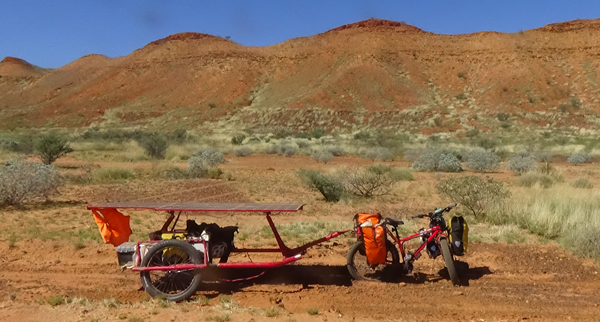 So why a trampoline?
So why a trampoline?
“A trampoline is really good because it’s got a really thick wall diameter and it’s really light,” Sam tells me over the phone from Sydney. “So you can make something quite rigid and fairly strong and not that heavy. And they’re easy to get a hold of.”
The experience Sam collected from his first solar-powered adventure was invaluable, as well as years of tinkering in the back shed of his parent’s house in Orbost, Victoria.
“As a kid and as a teenager I built weird bikes – tall bikes and tricycles and all that kind of stuff – from really terrible old bikes and bits of scrap metal. I had a renewable energy background and interest in the same time period, and had played around with solar panels and batteries and regulators…”
One of the most ingenious parts of the trailer design is the ability to run it offset to the bike, so that it doesn’t follow directly behind the bike, but off to the side a bit. Much of the Canning is made up of nothing but two wheel ruts, and this allows all four wheels of the rig to run in them, rather than on the soft and bumpy bit in the middle.
“I don’t think I would have made it through at all if I couldn’t do that,” says Sam.
The Canning’s fearsome reputation is in no small part due to its isolation, and as such, it’s a mission simply to get to either end of it. Leaving from Orbost, Sam travelled around 4,500km before he even reached the Canning, a journey that included the Tanami Road, itself a remote and challenging trek of around 1,000 kilometres.
So what was he thinking when he took his first pedal-strokes on one of the world’s more difficult tracks?
“Oh god, am I insane?” says Sam.
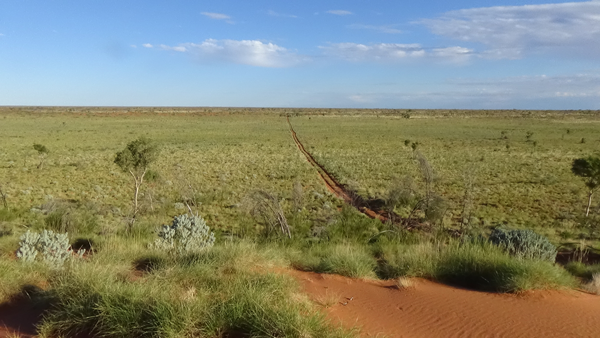 And did he ever think about turning back?
And did he ever think about turning back?
“Absolutely!” He says this as if it’s the most obvious thing in the world. “Bailing out, and how good my bailout options were, and where and when I could and couldn’t bail out, were front of mind from the get go. Halls Creek was my last easy bail out. Once I went past there I was thinking: ‘OK, I’m actually doing this, I’m actually doing this.’”
“The first two days were quite straightforward. On the third day I started hitting real sand and real corrugations and that was really draining. And I was very much considering how much worse this would have to get before I bailed out. I was pretty flat for quite a while.”
Was there ever a moment when those doubts ceased?
“When I got back onto the graded road 40km out of Wiluna (the end of the track),” Sam says half-jokingly. “There’s one easy bailout about half-way through, so for most of the first half, psychologically I was like: ’I’m just going to get to there and see how I’m going, and quite possibly bail.
“Once I’d got about half way, and I’d got into a bit of a rhythm, and I’d done what I was told were the worst of the dunes, I started to think ’Yes, I might actually be able to do this, I think I should actually make it.’”
Before I interviewed Sam for this story, I read his Facebook page about the journey, where to me he came across as a dauntless, devil-may-care adventurer; a tirelessly upbeat character who would think once before setting into the dusty beyond. But speaking to Sam made me realise that he was just an ordinary person with some vision, ingenuity and guts, and a healthy measure of fear like the rest of us.
It made me ponder the way social media wrings life into a shiny, idealised version of itself, and reminded me that very few people do great things in the absence of fear, but despite it; that as we travel through the physical world we grapple with our misgivings, and are forever negotiating an internal landscape of doubt.
The Canning’s 900 sand hills are its most challenging and well-known topographical feature, and for “upwards of half” of them, Sam had to unhitch his trailer and physically drag it over. This was physically the hardest part of the trip, according to Sam.
“There were sections where there was 600m of nice easy corrugated sand, and then 20 minutes pulling the trailer up a dune, and then another 600m, and then pull the trailer up another dune, and then 400m and pull the trailer up another dune, for like, two days. And then there were other times when I would pull the trailer up only three or four dunes a day.”
“Mentally, and overall, it (the hardest part) was getting through the third and fourth day when things started getting actually hard. Deciding to do it (ride the Canning) in the first place was also one of the harder bits.”
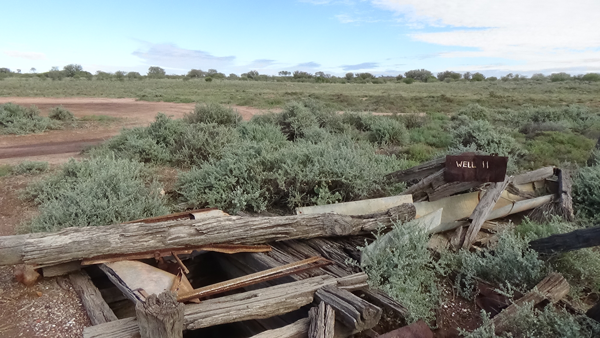 Being a former stock route, there are a number of old wells along the way that non-vehicular travellers rely upon to keep them alive. The longest gap between them is about 220km, or five days travel for Sam. Did he ever come close to running out of water?
Being a former stock route, there are a number of old wells along the way that non-vehicular travellers rely upon to keep them alive. The longest gap between them is about 220km, or five days travel for Sam. Did he ever come close to running out of water?
“Not dangerously close. I was very very very aware of it all of the time. At any point you could have asked me how much water I had left and I could have told you within a litre.”
Lack of water wasn’t the only scarcity though. Human company – a sort of water for the psyche – is another challenge for the solo adventurer. Sam saw about a couple of people a day, on average, but at times went for four or five days without seeing anybody.
While Sam was on the track there was, unusually, quite a lot of rain, which meant he had to contend not only with all the dunes, but large areas of sticky mud that clung to wheels and built up on everything else.
“It rained heavily three or four times on my way down the Canning. It wasn’t catastrophic, but my chain hates me. It wore out a lot of things.”
There was, though, a silver lining to the wet.
“Three or four days after a big rain event, seedlings would start popping up, and all the spinifex was a bit greener, and that was really nice to be able to watch.”
So how did the bike and trailer cope with the punishment of the journey?
“I had a couple of flat tyres but mechanically that’s all that went wrong with the bike. The trailer frame cracked a couple of times, which I had to weld back together off a battery.”
There is a video on Sam’s Facebook page of this procedure. It’s not unheard of for touring cyclists to need emergency welding while on the road, and usually one would seek out a local to do the job. This is the first person I’m aware of to carry a whole welding setup with them, and is probably one of the more remote and important welding jobs undertaken by a cyclist on the road. It got him through, but only just.
“At the end of the Canning pretty much everything on the trailer started falling apart. Within 100km I had two or three flat tyres, cracked welds, a wire fatigued through, I had a broken axle, and one of the tyres finally gave up.”
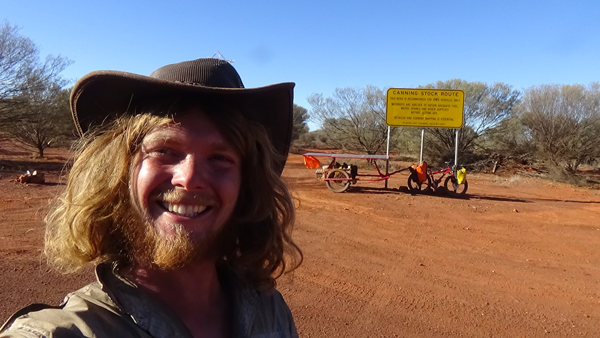 Sam reached Wiluna after 46 days of riding, and so became an ebike pioneer. Ebikes are taking off in cities, but what of their feasibility for long-distance, remote-area travel? Would it be easier to do it on a conventional bike, and just take less stuff?
Sam reached Wiluna after 46 days of riding, and so became an ebike pioneer. Ebikes are taking off in cities, but what of their feasibility for long-distance, remote-area travel? Would it be easier to do it on a conventional bike, and just take less stuff?
This from Sam’s Facebook page: “I rode the Canning much slower than any other unsupported cyclist ever has. I lost a lot less weight, and could fix almost anything that could break on the bike. Having the solar meant that I could go slow and steady and carry more luxuries (than on a conventional bike).”
Of course it depends on the conditions as well. Outback Australia, with its abundant sunshine, lends itself to solar-powered travel. Sam reckons that his rig was powered about 70% from the sun and 30% from his legs. It would be harder in less sunny parts of the world, though in more populated areas you could recharge using mains power.
More from the Facebook page: “The reality is that the trailer was built in the bush out of an old trampoline frame, as a one-off, with limited testing and refinement. A refined, extensively tested setup could quite possibly rival the times of a conventional fat bike.”
So what did he get most from the whole endeavour?
“Finishing a challenge that I thought was going to be very very hard – and was very very hard – was really good. It was really spectacular country, and being pretty well absolutely in the middle of nowhere, in really spectacular country, with just this crappy bike that you put together out of crappy stuff, is quite amazing.
“I don’t quite understand how harsh, dry desert can be really beautiful, but it manages to be somehow. Especially with the wet, having the spinifex flowering and the salt lakes full, that was really special.”
Ride On content is editorially independent, but is supported financially by members of Bicycle Network. If you enjoy our articles and want to support the future publication of high-quality content, please consider helping out by becoming a member.

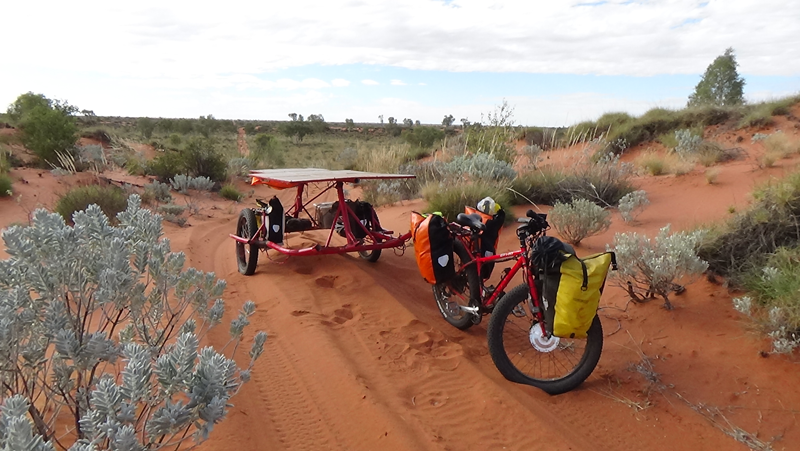
Crazy, but love it! Love the adventurous spirit shown. Thanks for telling the story.